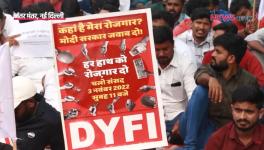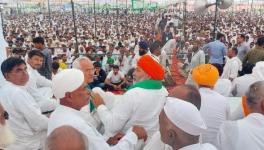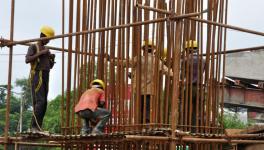From ‘Job-less’ to ‘Job-loss’ Economy: What is PM Modi Doing
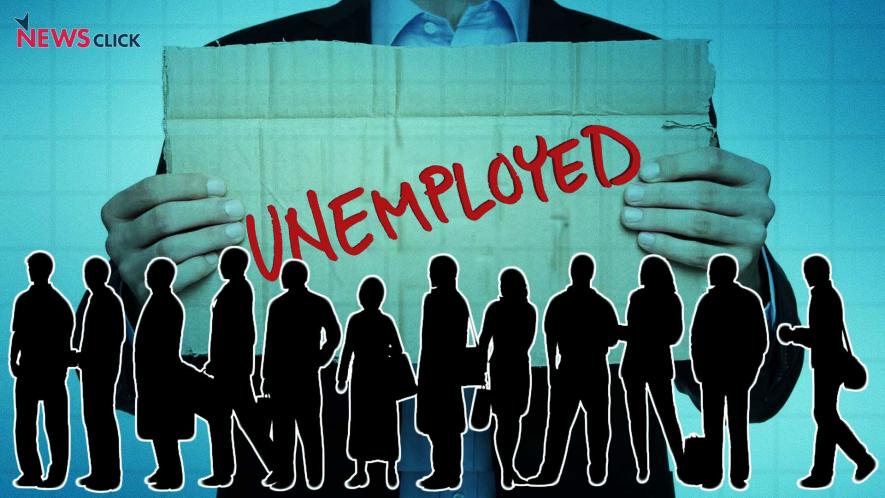
Newsclick Image by Nitesh Kumar
In a stark and chilling confirmation of what the whole country has known for some time, a govt. report shows that Indian workforce (those actually working) declined from about 54% of the working age population in 2011-12 to 51% in 2015-16. While the working age population increased by 2.9% per year during this period, the number of people with jobs increased at less than half the rate, at just 1.2% per year. These estimates emerge from the Labour Bureau’s Employment-Unemployment Survey reports for these years.
The falling work participation rate shows that the economy is in deep crisis. Various other economic indicators show this as well. Growth of credit flow to industry is at an all-time low, the index of industrial production is dipping, and wages in industry are stagnant. It is a crisis which is engulfing even those who own means of production, barring perhaps the big players.
The Labour Bureau’s data reveals a much bigger problem – the piling backlog of unemployed. Although the working age population increased by 4.66 crore between 2011-12 and 2015-16, those who were working increased by about 1.1 crore only. In other words, about 1.2 crore people become ready to work every year but only 0.2 crore actually get jobs.
The difference of about 3.5 crore comprises some who are not looking for jobs at all, like women or students. But the majority is of those who are unable to find jobs. If this backlog of unemployed keeps accumulating every year, a stupendous task confronts the government in coming years.
Rural areas, home to the country’s biggest workforce in agriculture, showed a small annual increase of only 1% in employment while jobs grew at 1.8% in urban areas. This reflects the over saturation of the agriculture sector with working people and its diminishing capacity to absorb new workers. Since jobs in industries and services do not seem to be opening up at a fast enough rate, the jobless are caught in a vicious cycle.
Another aspect, repeatedly brought out in various reports is the disguised unemployment rampant in India. A very large number of people are working at very low wages, or part time, or for a few months in different jobs interspersed with periods of joblessness. The Labour Bureau report for 2015-16 shows that just 61% of workers actually work for all 12 months of the year. The rest work less than that. In rural areas, this proportion is even lower at 52%.
Falling employment is just the big symptom of the crisis. Workers have been affected also by stagnating or falling wages. Take the growth in salaries and wages paid to workers/employees by the corporate sector. According to analysis of RBI data on corporate finances by CMIE, the average annual growth in real wages during the past three years (2014-15 through 2016-17) works out to 3.9%, far lower than the long term annual average of 6% and a median of 5%. It also compares very poorly with the real GDP growth rate of about 6 per cent during the same period.
The prospects for the future are looking dim because all the underlying factors seem to be in a fatal tailspin. Between July 2016 and July 2017, the Index of Industrial Production (IIP) released by the govt’s. Central Statistical Office (CSO) has increased by just 1.2% indicating almost no improvement. This means that industrial production is hardly growing. In which case, there is very little scope for increasing jobs and with an army of unemployed available, industrialists are likely to push down wages even more.
Similarly, between August 2016 and July 2017, bank credit to industry grew by just 0.4% and for the services sector by 4.6%, according to RBI data. Credit is a measure of how much economic activity is going on. A growth of this kind is negligible and is like no growth. This is likely to cast a long shadow in the coming months because Modi sarkar has no clue about how to revive production and growth. India is facing a dark economic crisis and sadly, the reins of power are held by people who are only interested in helping their cronies.

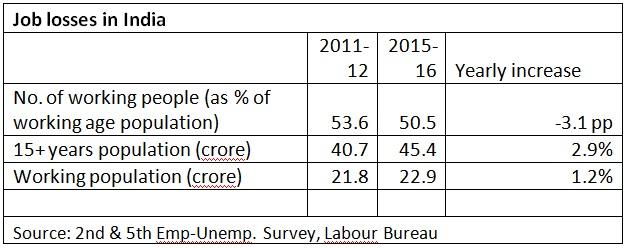
Disclaimer: The views expressed here are the author's personal views, and do not necessarily represent the views of Newsclick
Get the latest reports & analysis with people's perspective on Protests, movements & deep analytical videos, discussions of the current affairs in your Telegram app. Subscribe to NewsClick's Telegram channel & get Real-Time updates on stories, as they get published on our website.











